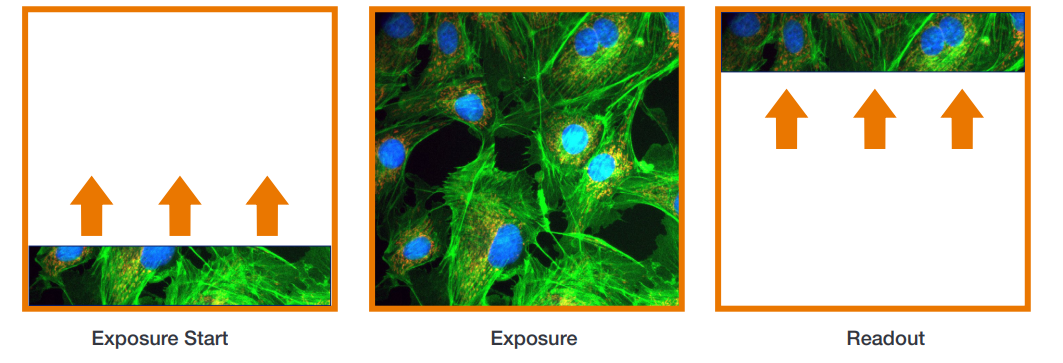Rolling Shutter
The Sona and Marana function in what is termed Rolling Shutter operation. This describes the sequence in which the lines of the pixels are read from the sensor array in a “rolling wave” effect. In Rolling Shutter, adjacent rows of the array are exposed at slightly different times as the readout waves sweep through the sensor. Each row will start and end its exposure slightly offset in time from its neighbour. The rolling shutter readout mechanism is illustrated below.

Rolling Shutter
-
At the start of an exposure, the “Reset” wave sweeps through the sensor clearing any accumulated charge from the pixels. The pixels then start accumulating light induced charge.
-
At the end of the exposure, the “readout” wave sweeps through the sensor, transferring the charge from each row into the readout node of each pixel.
So, whilst each row of pixels is exposed for exactly the same length of time they do not all start and end at exactly the same time i.e. the row at the top edge of the sensor would have started and ended its exposure after the rows at the bottom of the sensor.
Rolling shutter can be operated in a ‘continuous’ mode when capturing a kinetic series of images, whereby after each row has been read out it immediately enters its next exposure. This ensures a 100% duty cycle, meaning that no time is wasted between exposures and, perhaps more importantly, no photons are wasted. At the maximum frame rate for a given readout speed the sensor is continuously reading out, so as soon as the readout fronts reach the top of the sensor, they immediately return to the bottom to start readout of the next exposure.
Note: Rolling Shutter enables readout speeds to be maximised and the noise minimised - however a potential complication of this readout type is spatial distortion. This was more commonly associated with older CMOS
Exposure Start Exposure Readout camcorders were the image readout rate was not fast enough to keep up with a panned image. In modern sCMOS cameras however, the readout speeds are faster and rolling shutter is suitable for the majority of scientific applications. Some sCMOS cameras such as Neo and ZL41 Cell 5.5 can operate in a mode called Global Shutter as well as Rolling Shutter. Global Shutter which can be thought of as a “snapshot” as all pixels of the array are exposed simultaneously. This avoids spatial distortion, however frame rates are reduced and noise is higher when compared to operation in Rolling Shutter mode.